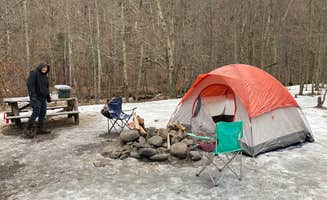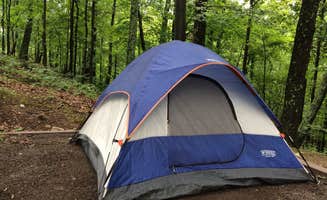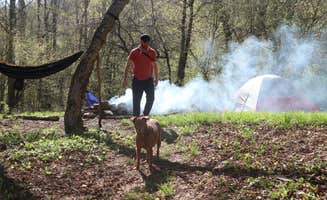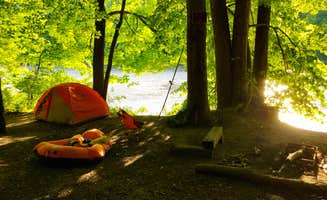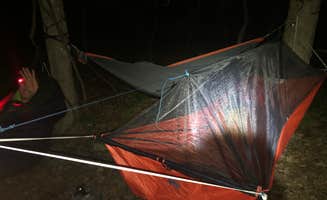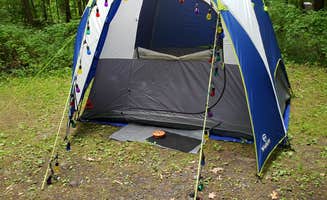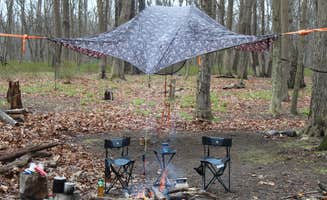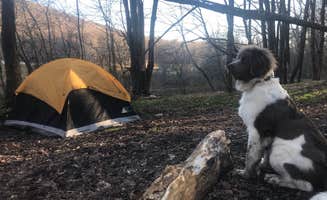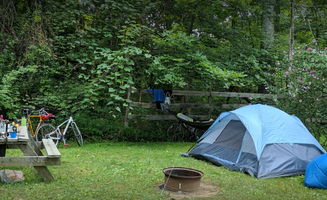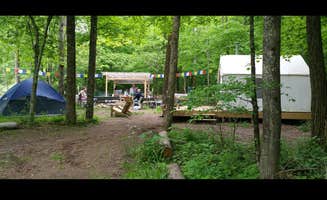Tent camping near Rock Hill, New York offers secluded forest experiences within the Delaware River Valley and Catskill Mountains at elevations ranging from 1,200 to 2,800 feet. Summer temperatures typically range from 55-85°F, with cooler mountain nights requiring extra layers even in July and August. Fall brings spectacular foliage viewing opportunities alongside notably colder nights from late September through October.
What to do
Blue Hole swimming: 4 miles from Peekamoose Valley camping areas, this natural swimming spot attracts visitors during summer months. A camper mentioned, "The Blue Hole is amazing and it's quite beautiful to stay right on the creek."
Hiking trails: Multiple difficulty levels available throughout the region, especially near Alder Lake. "The hike around the lake is a lovely, easy walk. The hike trail that connects to the far end of the lake is 6+ miles and while there were no real views, it was lovely," notes an Alder Lake visitor.
Rock climbing: World-class routes at Shawangunk Mountains, particularly accessible from gateway campgrounds. "This is the closest campground to world renowned rock climbing in 'the gunks' and also offers many other outdoor activities including some great hikes and rock scrambles, swimming holes and waterfalls. People travel from all over the world to rock climb here," explains a Samuel F. Pryor III Shawangunk Gateway Campground reviewer.
Waterfall viewing: Multiple locations within short driving distances of most campsites. "If you paddle across the river from the site, it is only a 10-15 minute hike along the road on the Pennsylvania side of the river to reach Raymondskill Falls. A 'must-see' if your stopping here," recommends a visitor to Namanock Island.
What campers like
Isolation from light pollution: Many sites offer excellent stargazing opportunities. On Namanock Island, "once darkness falls the absence of light sources beyond your camp remind you that you are truly alone in the wilderness."
Water proximity: Several tent sites provide direct water access. At the Peekamoose Valley, campers appreciate that "the other sites are nice right by the river, and there is plenty of privacy between spots."
Level tent pads: Finding flat ground for comfortable sleeping can be crucial. "The nicest, most level tent site you'll ever find. So easy to set up, and no worries whatsoever about roots or rocks," reports a camper at Giant Ledge Primitive Camp.
Community spaces: Some established campgrounds foster social interaction. "There is a pavilion near the fire ring with sinks and bathrooms with pay showers. They are kept relatively nice," notes a camper at Samuel F. Pryor III Shawangunk Gateway Campground.
What you should know
Bears are active: Most tent camping areas require proper food storage. "With all the heavy bear traffic signs that were up, I was surprised to see how close bear boxes were to our tents. They seemed to be 1-10 feet away from tents in each campsite," observed a Shawangunk Gateway visitor.
Limited or no cell service: Most campsites have minimal connectivity. "No cell service whatsoever (Verizon)" reported a Peekamoose Valley camper.
Bugs can be problematic: Insect activity varies by season and location. "The sites 11-15 are within 50 feet of a wet area, and the bugs in late May were pretty annoying," warned a camper at Shawangunk Gateway Campground.
Winter camping accessibility: Some areas remain open year-round but with limited amenities. "Camped out at one of the sites by the river and it was amazing, no one was around except a man far from our site. Good walking distance to the car especially in the cold!" shared a visitor to The Peekamoose Valley.
Tips for camping with families
Pack a wagon for gear transport: Some sites require walking from parking areas. "I was in the lower area and had to walk pretty far with everything and make at least 6-8 trips for each load-in and out. I went and bought a wagon after the first day to carry the firewood down to our site."
Check tent site placement carefully: Some locations have less-than-ideal spots. "Site #6 is directly on the path, so people camping past you need to actually walk through your site and I feel it was more awkward for them as well," notes a Peekamoose Valley camper.
Consider drive-up sites for easier access: Some campgrounds offer both walk-in and drive-up options. "There are drive-up sites and also walk-in sites," explains a Wawayanda State Park visitor, which can be crucial when camping with children or larger amounts of gear.
Bring wildlife identification materials: The rich ecosystem provides educational opportunities. "Local wildlife, you can expect to be visited by a masked robber or two during the night, but a bear bag handing will eliminate any issues," notes a Namanock Island camper.
Tips from RVers
Access limitations for larger vehicles: Many roads leading to campgrounds have restrictions. A camper at Port Jervis Elks Brox Hiker/Biker Campground observed, "I would not drive an RV in here except maybe a small type trailer."
Consider smaller campervans: Compact RVs can access more locations. "I have a Nissan rogue and made it in no problem. It's .8 miles in on the right," notes another camper about the access road conditions.
Limited RV facilities: Most tent-focused campgrounds lack hookups or dump stations. "There is a trailer field for a total of 24 campsites. Calling them 'fields' might be misleading - they're heavily wooded areas by a river," explains a Peekamoose Valley camper, highlighting that RV camping in this area often means a more primitive experience.


